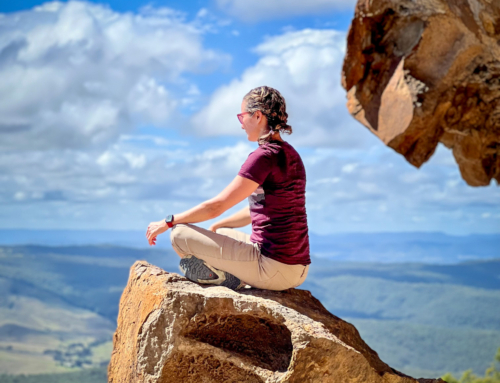Surya Namaskar is one of the most important yoga practices. It is these of yoga poses which can be performed while listening or chanting along to mantras. Mantras help to focus the mind and add a profound spiritual element to the practice.
Surya means “sun” and namaskar means “salutations.”
Sometimes translated as “eternal salutations to the sun.” Surya Namaskar awakens the body intelligence to create energy directly from the sun. In the Vedic tradition, the sun is symbolic of consciousness and, therefore, has been worshiped daily in the Indian culture.
The Sun represents the physical and spiritual heart of the world. We salute the Sun to give thanks for a new day filled with life-giving light and sustenance.

This practice evolved to work on all body parts, every organ, every system, and every chakra. It is also believed to be the most efficient way to connect with our core inner strength.
Due to a beautiful combination the postures and the repetitive nature of Surya Namaskar, it allows individuals to perform self-motivated practice without getting bored or mindless and it allows for easy self-maneuvering since it is repetitive in nature
The original Surya Namaskar wasn’t a sequence of postures, but rather a sequence of sacred words. The Vedic tradition, which predates classical yoga by several thousands of years, honored the sun as a symbol of the Divine. According to
Ganesh Mohan, a Vedic and yoga scholar and teacher in Chennai, India, Vedic mantras to honor the sun were traditionally chanted at sunrise. The full practice includes 132 passages and takes more than an hour to recite. After each passage, the practitioner performs a full prostration, laying his body face-down on the ground in the direction of the sun in an expression of devotion.

Adding mantras during the practice removes monotony provides harmony within and produces soothing vibrations that remove fatigue.
- Mudras, like namaste bring humility and remove self-binding ego in the practitioner.
- Salutations to the sun, the visible divinity in nature, allows one to practice in faith. Visualizing the sun in one’s heart center brings a sense of peace and wholeness.
The body is equipped with the innate intelligence to produce energy from the sun directly. The mind, through the solar plexus; the body, through physical movement; and the spirit, through the chants, all get a boost from the practice of Surya Namaskar. Therefore, it is a complete workout for the mind, body, and soul.
The connection between the sun and the Divine continues to appear throughout the Vedic and yoga traditions. However, the origins of Surya Namaskar in modern hatha yoga are more mysterious. “There is no reference to asanas as ‘Sun Salutation’ in traditional yoga texts,” Mohan says.
So where did this popular sequence come from? The oldest-known yoga text to describe the Sun Salutation sequence, the Yoga Makaranda, was written in 1934 by T. Krishnamacharya, who is considered by many to be the father of modern hatha yoga. It is unclear whether Krishnamacharya learned the sequence from his teacher Ramamohan Brahmachari or from other sources, or whether he invented it himself.

In The Yoga Tradition of the Mysore Palace, yoga scholar N.E. Sjoman identifies an earlier text called the Vyayama Dipika (or “Light on Exercise”) that illustrates athletic exercises for Indian wrestlers, including some that are strikingly similar to Krishnamacharya’s version of Surya Namaskar.
“Certainly, modern asana practice—and Surya Namaskar, after it was grafted on to it—is an innovation that has no precedent in the ancient Indian tradition, but it was rarely formulated as ‘mere gymnastics,'” says Mark Singleton, author of Yoga Body: The Origins of Modern Posture Practice. “More often, it was conceived within a religious [Hindu] framework and was seen as a spiritual expression as well as a physical one.

But in modern India, for many people, it made complete sense for physical training to be conceived as a form of spiritual practice, with no contradiction implied.”
So, it appears that Krishnamacharya was influenced by both athletics and spiritual practice, and it was the emphasis he placed on the breath and on the devotion that set his teaching of yoga asana apart from a purely athletic endeavor.
Whether teaching the Vedic mantras or the sequence of postures, the intention is the same. “One is offering salutation to the Divine, represented by the sun, as a source of light removing the darkness of a clouded mind and as a source of vitality removing the diseases of the body,” says Mohan.
Krishnamacharya taught the sequence to his students, including K. Pattabhi Jois (founder of the Ashtanga Yoga system), B.K.S. Iyengar (founder of the Iyengar Yoga system), and Indra Devi (recognized as the first Western woman to teach yoga around the world). These students went on to become internationally prominent teachers and to inspire much of the practice in the West. As a result, Sun Salutations became an integral part of our modern practice.

Breath + Mantra Drive Surya Namaskar
To enjoy the full experience of Surya Namaskar, Shiva Rea recommends four things. First, let the breath lead the movement. Each inhalation and exhalation should draw you into and through the next pose, and not be forced to fit a predetermined pace. “When you go into that state of following the breath, you are following the source,” she says. “That is the heart of yoga.” Also, take the time to fully contemplate the meaning of what Surya Namaskar is and to sense your authentic gratitude to the sun. “All of life on Earth depends on the sun,” says Rea. “Contemplating the vitality you receive from the elements allows you to go to a deeper level of participation with the movements of the sequence.”
Rea also recommends adding a mantra to the movements. “With the mantra, you really start to feel the spiritual activation of Namaskar,” she explains.
Practice Sun Salutations in the Morning
Although Sun Salutations can be practiced at any time of the day, the early-morning hours are considered especially auspicious for yoga and meditation practice. The hour just before sunrise is called Brahma muhurta (“time of God”). “The mind is supposed to be most calm and clear at this time. Ayurveda recommends that one awake at this time every day,” says Mohan.
For most of us, early morning is one time of the day we can be alone, without demands and distractions. Rising a bit early can allow you to experience inner stillness and offer your energy to a greater intention for your day. Surya Namaskar is the perfect morning practice to awaken the body, focus the mind, and connect to a sense of gratitude for the new day. “An extra one to two hours of sleep cannot equal the energy of the sunrise,” Rea says.”Celebrating being alive is the essence of a spiritual experience.”
If getting up to practice yoga before sunrise seems intimidating or impossible, you can capture the feeling of Surya Namaskar by doing a simple morning ritual whenever you wake up. Bring the attitude of the Sun Salutation to your heart and mind, face the direction of the rising sun, and offer a formal bow of gratitude. “Even in long winters, you can face the sun,” says Rea. “Visualize that you have the sun inside your heart. Part of Surya Namaskar is really being able to see the sun inside yourself.”






One of the best pieces I’ve read on sun salutations. Thank you.